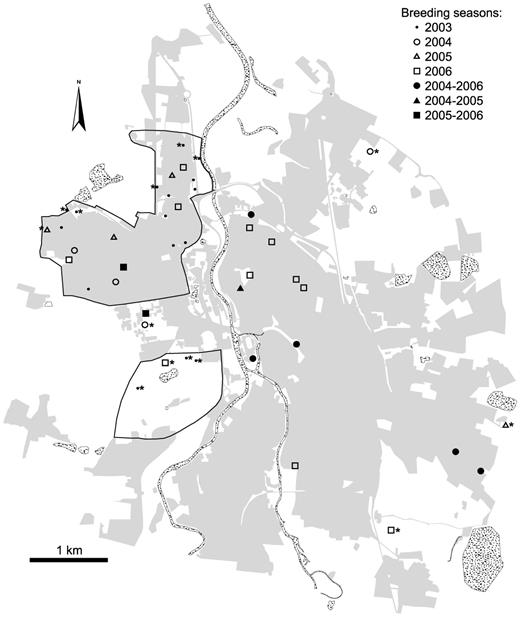Lövy, M., & Riegert, J. (2013). Home Range and Land Use of Urban Long-Eared Owls. The Condor, 115(3), 551–557. https://doi.org/10.1525/cond.2013.120017
Certain bird species have become iconic symbols of urban areas. Rock doves are heavily associated with cities, along with some other species such as house sparrows. Most people often think of smaller and more herbivorous species. But what about larger birds of prey? This study looked at long-eared owls in České Budějovice, which is a city in the Czech Republic. The researchers specifically looked at the home ranges of the urban population, and compared them with suburban populations. The long-eared owl can be found year-round in North America, Europe, and Asia. They are nocturnal and notably have good camouflage. In the area of study, Europe, they are known to select open farmland. They commonly feed on rodents. Within the last couple of decades (in reference to 2013) there has been an increase in urban populations of the long-eared owl. The study correlates this to the number of common magpies, as long-eared owls can breed in their old nests.
The city of České Budějovice was studied from 2004-2006, which equates to three breeding seasons for the long-eared owl. The study area was 154 km^2 (95.6912 mi^2). It was 51% developed area, 17% field, 12% meadow, 7% wooded, 4% orchards, 4% lawns (defined as mowed regularly), 2% abandoned areas, and 4% water. They counted nesting opportunities by counting active magpie nests in certain areas. To determine the level of urbanization around each of those magpie nests, they defined a radius of 0.5 km^2 (0.310686 mi^2). Then, if the area was more than 50% developed it was classified as urban while less than 50% was suburban. To locate owls in the area, they would play a territorial male call. They would then only visit sites with regular responses and then use sites that only had successful breeding.

This study utilized radio telemetry. To attach transmitters to the owls, they used mist nets. The researchers used a stuffed eagle owl to attract the long-eared owls to the net. Backpack transmitters were then put on nine owls, specifically four pairs and one lone male. Two pairs (referred to as pair P and B) and the lone male (male V) were classified as urban. Two pairs (referred to as pair K and M) were classified as suburban. Antenna and receivers were used to locate the owls. The telemetry surveying took place while adults were providing for offspring. Visual tracking was also possible due to the city’s street lights. Each owl was observed for 8-12 nights which totaled 93 sessions of radio telemetry.
During the three years this study was conducted long-eared owl nests increased. Suburban nests were steady while urban nests increased from 8 to 16. They found that the home range of urban owls was significantly larger than their suburban counterparts. There was also more range overlap with the urban owls. The owls did not show a significant selection of vegetation types for establishment, but they would select specific types within their home ranges. In their home range, they selected, in order of favorability, wooded areas, meadows, abandoned areas, fields, lawns, buildings, then orchards.

This study can be used in a variety of ways. If the goal is to coexist and promote long-eared owls, this study provides many things that can be done. Firstly, magpies (or other primary nest sources) should be promoted. Common magpies, also known as Eurasian magpies, nest in crowns of tall trees or even on top of electrical pylons. Due to the risk associated with electrical pylons, the tree crown option should be promoted. More focused on owls, hunting habitat would also need to be promoted. This can overlap with lots of other wildlife, as generally forested or more “nature” areas are ideal. This research could be used in many areas. Even if the European population of long-eared owls shows slight differences, general behavior should be similar in other continents.
This study was conducted in the early 2000s, and lots of advancements have been made since then. Specifically regarding radio telemetry. I’m sure if this study took place now, they would be able to get much more precise data. The more frequent and precise data could help pinpoint the home ranges, activity times, and other aspects.